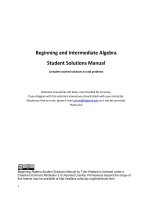- Trang chủ >>
- Y - Dược >>
- Ngoại khoa
operative surgery 2nd ed
Bạn đang xem bản rút gọn của tài liệu. Xem và tải ngay bản đầy đủ của tài liệu tại đây (7.67 MB, 883 trang )
Preface to first editionA
i
OXFORD MEDICAL PUBLICATIONS
Operative Surgery
ii
Oxford University Press makes no representation, express or implied,
that the drug dosages in this book are correct. Readers must therefore
always check the product information and clinical procedures with the
most up-to-date published product information and data sheets provided
by the manufacturers and the most recent codes of conduct and safety
regulations. The authors and the publishers do not accept responsibility
or legal liability for any errors in the text or for the misuse or misapplica-
tion of material in this work.
iii
Operative
Surgery
Second edition
Edited by
Greg R. McLatchie
Professor of Sports Medicine and Surgical Sciences,
University of Sunderland, UK
David J. Leaper
Emeritus Professor of Surgery,
University of Newcastle upon Tyne, UK
i
v
Great Clarendon Street, Oxford OX2 6DP
Oxford University Press is a department of the University of Oxford.
It furthers the University’s objective of excellence in research, scholarship,
and education by publishing worldwide in
Oxford New York
Auckland Cape Town Dar es Salaam Hong Kong Karachi
Kuala Lumpur Madrid Melbourne Mexico City Nairobi
New Delhi Shanghai Taipei Toronto
With offices in
Argentina Austria Brazil Chile Czech Republic France Greece
Guatemala Hungary Italy Japan Poland Portugal Singapore
South Korea Switzerland Thailand Turkey Ukraine Vietnam
Oxford is a registered trade mark of Oxford University Press
in the UK and in certain other countries
Published in the United States
by Oxford University Press Inc., New York
© Oxford University Press 2006
The moral rights of the authors have been asserted
Database right Oxford University Press (maker)
First edition published 1996
Reprinted 1998, 2001, 2002
Second edition published 2006
All rights reserved. No part of this publication may be reproduced,
stored in a retrieval system, or transmitted, in any form or by any means,
without the prior permission in writing of Oxford University Press,
or as expressly permitted by law, or under terms agreed with the appropriate
reprographics rights organization. Enquiries concerning reproduction
outside the scope of the above should be sent to the Rights Department,
Oxford University Press, at the address above
You must not circulate this book in any other binding or cover
and you must impose the same condition on any acquirer
British Library Cataloguing in Publication Data
Data available
Library of Congress Cataloging in Publication Data
Data available
Typeset by Newgen Imaging Systems (P) Ltd., Chennai, India
Printed in Italy
on acid-free paper by Legoprint S.p.A.
ISBN 0–19–851056–X (flexicover: alk.paper) 978–0–19–851056–7 (flexicover
: alk.paper)
10 9 8 7 6 5 4 3 2 1
v
Preface to first edition
This book is a practical guide for the surgeon or surgical trainee about to
perform or assist at an operation. The procedures described are those
commonly carried out in general, urological, and orthopaedic surgical
practice with an introduction on perioperative management and anaes-
thetics. These should also prove of interest to operating department
nurses, assistants, and students of medicine. Indications for and complica-
tions of procedures are given but more extensive descriptions of these
can be found in surgical text books to which the reader should refer.
We emphasize that the book is not for the first-time operator nor
does it embrace the philosophy of ‘see one, do one, teach one’. Anyone
aspiring to be a surgeon must acquire the basic skills of safe knot-tying
and familiarity with surgical instruments. Only by witnessing, assisting at,
and then performing many procedures within the structure of a formal
surgical training course can the trainee develop the skill, judgement, and
the ability to select patients correctly—the recipe for safe surgery.
GRM
Hartlepool
DJL
Stockton on Tees
1996
Preface to second edition
The text and increased numbers of contributors reflect the changes that
have occurred in General Surgery over the past ten years. It is unlikely
that in the future we will encounter General Surgical Units. They will be
replaced by specialised departments catering for specific areas of surgical
expertise. These changes will also fashion future editions of this text in
that almost every chapter will become a handbook in itself and the train-
ing of surgeons become significantly changed.
GRM
DL
North Tees and Hartlepool NHS Trust
April 2006
vi
Dedications
For Ross, Cameron, Ailidh, Claire, Calum, Charles, Alice, Stephen,
Rebecca, and Amy
vii
Acknowledgements
We are grateful to all who have helped us to produce this book,
in particular the staff of Oxford University Press. We thank Luca
Di Franco for some of the illustrations and Paul Rodgers who took
photographs. Staff on the Surgical Wards at the University Hospital of
Hartlepool; Debbie Blackwood, Dean Trainer, Nicola Jones and
Elizabeth Redden, deserve special mention, as does Anneli Thornton
who prepared the manuscript.
This page intentionally left blank
ix
Contributors
Mr A. K. Agarwal
Consultant Surgeon,
North Tees & Hartlepool
NHS Trust
Mr S. Aspinall
Specialist Registrar,
Northern Deanery
Professor B. S. Avery
Consultant Oral &
Maxillofacial Surgeon,
James Cook University Hospital,
Middlesbrough
Mr R. Carter
Lister Department of
Pancreatico-biliary surgery,
Glasgow Royal Infirmary
Mr A. E. Clason
Consultant Vascular Surgeon,
James Cook University Hospital,
Middlesbrough
Mr F. Di Franco
Specialist Registrar,
Northern Deanery
A. J. Dickenson
Consultant Maxillofacial Surgeon
Mr. S. Dresner
Consultant Surgeon,
James Cook University Hospital,
Middlesbrough
Mr H. El-Khalifa
Associate Specialist,
North Tees & Hartlepool
NHS Trust
Mr M. El-Sheikh
Consultant Surgeon,
Nottingham City Hospital
NHS Trust
Mr T. Friesem
Consultant Spinal Surgeon,
North Tees & Hartlepool
NHS Trust
Mr A. Gilliam
Specialist Registrar,
Northern Deanery
Mr C. Harding
Consultant Urologist,
North Tees & Hartlepool
NHS Trust
Mr L. Horgan
Consultant Surgeon,
Upper GI and Laproscopic
Surgical Unit,
North Tyneside General
Hospital
Professor C. W. Imrie
Lister Department of
Pancreatico-biliary Surgery,
Glasgow Royal Infirmary
Dr P. Kalia
Consultant Anaesthetist,
North Tees & Hartlepool
NHS Trust
Mr V. J. Kurup
Consultant Surgeon,
North Tees & Hartlepool
NHS Trust
Mr Q. King
Consultant Urologist,
North Tees & Hartlepool
NHS Trust
CONTRIBUTORS
x
Contributor
Professor David J. Leaper
Emeritus Professor of Surgery,
North Tees & Hartlepool
NHS Trust
Mr P. A. Lear
Consultant Vascular and
Transplant Surgeon,
North Bristol NHS Trust
Professor T. Lennard
School of Surgical and
Reproductive Sciences,
Newcastle upon Tyne
Professor G. R. McLatchie
Consultant Surgeon,
North Tees & Hartlepool
NHS Trust
Dr D. Monkhouse
Specialist Registrar,
Anaesthetics,
Northern Deanery
A. N. Morritt
Consultant Cardiothoracic
Surgeon,
James Cook University Hospital,
Middlesbrough
Mr G. O’Dair
Specialist Registrar
Northern Deanery
Mr P. Raine
Royal Hospital for Sick Children,
Glasgow
Mr S. Rawat
Upper GI and Laparoscopic
Surgical Unit,
North Tyneside General Hospital
Mr C. M. S. Royston
Department of General Surgery,
Hull Royal Infirmary
Mr J. Shenfine
Specialist Registrar
Mr D. Southward
Consultant in Accident &
Emergency,
North Tees & Hartlepool
NHS Trust
Mr Y. K. S. Visnarath
Consultant Surgeon,
James Cook University
Hospital,
Middlesbrough
Mr G. Walker
Specialist Registrar in Paediatric
Surgery,
Glasgow
xi
Contents
Symbols and abbreviations
xii
1
Perioperative anaesthetic care and
practical procedures
2 Theatre procedures and prophylaxis
3 Anatomy for surgeons
4
Surgical instruments, materials, and
the acquisition of surgical skills
5 Breast and endocrine surgery
6 Upper gastrointestinal surgery
7
Colorectal surgery, appendix, and
small bowel
8 Hepatobiliary surgery
9 Laparoscopic surgery
10 Stapling in surgery
11 Hernias
12 Peripheral vascular surgery
13 Urology
14 Paediatric surgery
15 Head and neck surgery
16 Thoracic surgery
17 Principles of plastic surgery
18 Trauma surgery
19 Transplantation
Index
857
1
29
45
91
147
225
323
351
367
379
475
185
639
567
691
759
813
833
305
xii
Symbols and abbreviations
> greater than
< less than
¥
increased
decreased
·
and/or
≥
greater than or equal to
A&E accident and emergency
ABC airway, breathing, circulation
ABPI Association of the British Pharmaceutical Industry
ACE angiotensin-converting enzyme
ACTH adrenocorticotropic hormone
AGNB aerobic Gram-negative bacilli
AJCC American Joint Committee on Cancer
APE abdomino-perineal excision
APLS antiphospholipid antibody syndrome
APTTR activated partial thromboplastin time ratio
ARDS acute respiratory distress syndrome
ASIS
American Society for Information Science or anterior
superior iliac spine
ATLS advanced trauma life support
BKA below knee amputation
BMI body mass index
Bpm beats per minute
BXO balanitis xerotica obliterans
CBD chronic beryllium disease
CCF congestive cardiac failure
CCU Coronary Care Unit
CDH congenital diaphragmatic hernia
CJD Creutzfeld–Jakob disease
CMV cytomegalovirus
CNS central nervous system or coagulase negative staphylococcus
COH congenital diaphragmatic hernia
CRF chronic renal failure
SYMBOLS AND ABBREVIATIONS
xiii
CSF cerebrospinal fluid
CT computed tomography
CVP central venous pressure
CXR chest X-ray
DGF delayed graft function
DJ duodenal-jejunal
DPL diagnostic peritoneal lavage
DVT deep vein thrombosis
EBV Epstein–Barr virus
ECG electrocardiogram
EHL extensor hallucis longus
EMLA entectic mixture of local anaesthetic
ENT ear, nose, throat
ERCP endoscopic retrograde cholangio-pancreatography
ESWL extracorporeal shockwave lithotripsy
EUA examination under anaesthetic
EUS endoscopic ultrasound
FBC full blood count
FEV
1
forced expiratory volume (in 1 second)
FHL familial erythrophagocytic lymphohistiocytosis or flexor
hallucis longus
FNAC fine needle aspiration cytology
FVC forced expiratory vital capacity
GERD gastrooesophageal reflux disease
GJ gastro-jejunal
GKI glucose/potassium/insulin
GOJ gastro-oesophageal junction
GOS Great Ormond Street
H&P history and physical examination
HDU high dependency unit
Hib Haemophilus influenza type b
HIV human immunodeficiency virus
HLA human leucocyte antigen
HRT hormone replacement therapy
HSV herpes simplex virus
ICU intensive care unit
IL-1 interleukin 1
IM intramuscular
SYMBOLS AND ABBREVIATIONS
xi
v
IMA inferior mesenteric artery
IMV inferior mesenteric vein
INR international normalized ratio
IPF initial poor function
IPMT intraductal papillary mucinous tumour
ITU intensive therapy unit
IVC inferior vena cava
JVP jugular vein catheterization
kPa kilo Pascals
LES lower esophageal sphincter
LFT liver function tests
LIF left iliac fossa
LMU lower, middle, upper
LMWH low molecular weight heparin
LOS lower oesophageal sphincter
LSV long saphenous vein
LUS laproscopic ultrasonography
MAO-A monoamine oxidase A
MI myocardial infarction
MIBG meta iodo benzyl guanidine
MIBI myocardial perfusion imaging
MIDN minimally invasive donor nephrectomy
MITS minimally invasive thoracoscopic splanchnicectomy
MOA monoamine oxidase inhibitors
MRCP magnetic resonance cholangio-pancreatography
MRI magnetic resonance imaging
MRSA methicillin-resistant Staphylococcus aureus
NG naso-gastric
NHB non-heart beating
OA oesophageal atresia
OGD oesophagogastroduodenoscopy
OTE otitis media with effusion
PAC pulmonary artery catheterization
PAIs plasminogen activator inhibitor
PAK pancreas after kidney
PALS paediatric advanced life support
PCA patient-controlled analgesia
SYMBOLS AND ABBREVIATIONS
xv
PCNL percutaneous nephrolithotomy
PE pulmonary embolism
PEEP positive end expiratory pressure
per anum though the anus
PNF primary non-function
PONV postoperative nausea and vomiting
PPPD pylorus preserving pancreatico-duodenectomy
PSARP posterior sagittal anorectoplasty
PT prothrombin time
PTA pancreas transplantation alone
PTFE polytetrafluoroethylene
PTH parathormone
PTLD post-transplant lymphoproliferative disease
PTT partial thromboplastin time
PUJ pelviureteric junction
PVC polyvinylchloride
RA right atrium
RCC renal cell carcinoma
RI resistance index
RIF right iliac fossa
RIND reversible ischaemic neurological deficit
RSTL relaxed skin tension line
rTPA recombinant tissue plasminogen activator
SAGB Swedish adjustable gastric band
SEPS subfascial endoscopic perforator surgery
SFA superficial femoral artery
SMA superior mesenteric artery
SMV superior mesenteric vein
SPK simultaneous pancreas-kidney
SSRIs selective serotonin reuptake inhibitors
SSSI superficial surgical site infection
SVC superior vena cava
TAPP transabdominal preperitoneal
TB tuberculosis
TBSA total body surface area
TCC transitional cell carcinoma
TED thromboembolic deterrent
SYMBOLS AND ABBREVIATIONS
xvi
TEP totally extraperitoneal
TNF tumour necrosis factor
TOF tetralogy of Fallot
TOR target of rapamycin
tPA tissue plasminogen activator
TRAM tranverse rectus abdominis myocutaneous
TURBT transurethral resection of bladder tumour
TURP transurethral resection of prostate
U units
ULTRA Unrelated Live Transplant Regulatory Authority
UTI urinary tract infection
UVPPP uvulopalatopharyngoplasty
VATS video assisted thoracic surgery
VT ventricular tachycardia
YAG yttrium aluminum garnet
Chapter 1
1
Perioperative anaesthetic
care and practical
procedures
P. Kalia and D. Monkhouse
Preoperative evaluation 2
Airway assessment 2
Respiratory system 2
Cardiovascular system 2
Myocardial infarction (MI)
and congestive cardiac
failure (CCF) 3
Hypertension 3
Valvular and congenital
heart disease 3
Diabetes mellitus 3
Renal system 3
Hepatic system 4
Haemopoetic system 4
Pregnancy 4
Social history 4
Family history 5
Laboratory investigations 5
Preoperative medication—
continue or stop? 6
Medications to be
continued 6
Medications to be stopped 6
Intraoperative
complications 8
Patient factors 8
Surgical factors 8
Anaesthetic factors 8
Cardiovascular
problems 8
Supraventricular arrhythmias
11
Ventricular arrhythmias 11
Ventricular fibrillation 12
Respiratory complications 12
Adverse drug reactions 15
Postoperative
complications 18
Hypoxia 18
Nausea and vomiting 18
Hypotension 18
Hypertension 19
Sore throat 19
Practical procedures 19
Peripheral venous
cannulation 19
Arterial cannulation 20
Central venous
cannulation 21
Pulmonary artery
catheterisation (PAC) 22
Oropharyngeal airway
insertion 23
Nasopharyngeal airway
insertion 24
Laryngeal mask airway (LMA) 25
Orotracheal intubation 27
Indications of intubation 27
Complications of intubation 27
Cricothyroidotomy 27
Tracheostomy 28
CHAPTER 1
Perioperative anaesthetic care
2
Preoperative evaluation
Assessment of the patient before elective inpatient, day case, or
emergency surgery is mandatory. Unnecessary cancellations are thereby
avoided. Lack of preoperative assessment increases the risks associated
with anaesthetics and surgery. The main goals of the preoperative visit
are to:
Establish rapport with the patient besides allaying apprehensions
and anxieties.
Assess fitness for anaesthesia and surgery by detailed history, physical
examination, and laboratory investigations.
Control of medical conditions before elective surgery.
Plan the anaesthetic technique.
Discuss options with the patient (general versus local anaesthesia).
Prescribe premedication and drugs that need to be continued or
stopped.
Plan postoperative care, including pain relief, HDU, or ICU care.
Obtain informed consent.
Airway assessment
Factors leading to difficult intubation should be identified. Assessment of
the airway is the most important part of preoperative assessment, as
failure to maintain the airway can result in life-threatening hypoxia. Any
past history of a difficult intubation should be documented. Obesity,
short neck, limited neck movement, decreased mouth opening, pro-
minent upper incisors, micrognathia, congenital abnormalities (cystic
hygroma, Pierre Robin, and Treacher Collins syndrome), and facial
trauma can lead to difficult intubation. A thyromental distance of less
than 6.5cm can be indicative of a difficult intubation.
Respiratory system
Patients with pre-existing lung disease (such as chronic obstructive airway
disease or asthma) and poor lung function have a higher incidence of
postoperative pulmonary complications. Upper respiratory tract infection
should be treated before elective surgery. Asthmatic patients have
increased airway reactivity and can develop acute bronchospasm during
laryngoscopy or intubation. Local or regional anaesthesia may be a safer
option.
Cardiovascular system
A detailed history should be taken regarding dyspnoea, angina, palpita-
tions, orthopnoea and paroxysmal nocturnal dyspnoea. The patient’s
functional capacity should be determined as this correlates well with
maximum oxygen uptake on treadmill testing and can be prognostically
significant. Physical examination should include assessment of heart rate
and rhythm with measurement of blood pressure and JVP. The chest
should be auscultated to detect murmurs or additional heart sounds.
PREOPERATIVE EVALUATION1
3
Myocardial infarction (MI) and congestive cardiac
failure (CCF)
A history of recent MI or CCF places the patient in a high-risk category.
This necessitates full investigation and treatment prior to elective sur-
gery. The incidence of reinfarction following surgery has been
reported to range from 0–37% depending on the timing of surgery rela-
tive to MI. Surgery performed 3–6 months after MI is associated with a
reinfarction rate of 15%. Mortality from postoperative infarction is in the
order of 40–60%. Consequently, elective surgery should be deferred until
6 months after a MI.
Patients with symptomatic coronary artery disease should be investi-
gated preoperatively to stratify risk. Exercise stress testing and angiogra-
phy may be of value in deciding whether the patient will benefit from
coronary revascularisation prior to elective general surgery. The duration
and type of surgery is also important. Vascular surgery carries a higher
risk of perioperative MI (10.9%) than abdominal surgery (4.3%).
Hypertension
Affected patients should be assessed for adequacy of control and in-
volvement of target organs (heart and kidney). Patients with uncontrolled
hypertension exhibit wide fluctuations of blood pressure intraoperatively
because of increased reactivity of blood vessels to sympathetic stimula-
tion. Wide swings of blood pressure can precipitate myocardial ischaemia
or stroke.
Valvular and congenital heart disease
Patients with either valvular pathology or congenital heart disease
present a major anaesthetic challenge. The exact nature of the cardiac
problems should be known preoperatively and the condition optimised.
Concurrent problems such as chest infection and cardiac failure should
be treated aggressively. These patients are at risk of acquiring infective
endocarditis and prophylactic antibiotic administration is mandatory.
Diabetes mellitus
Diabetic control should be assessed. Random blood glucose levels are of
limited value. Glycosylated haemoglobin levels are preferable. Patients
should be assessed for complications of diabetes such as hypertension,
ischaemic heart disease, renal disease, infection and autonomic and peri-
pheral neuropathy. Preoperative assessment should be geared towards
optimising perioperative blood glucose control and minimising complica-
tions associated with the coexisting pathologies.
Renal system
There is a broad clinical spectrum of disease from mild renal dysfunction
to end-stage renal failure. Patients with preoperative renal dysfunction
are more likely to develop postoperative renal failure, particularly after
aortic or cardiac surgery.
CHAPTER 1
Perioperative anaesthetic care
4
Anaemia, hypertension, ischaemic heart disease and diabetes may
complicate the picture. Care should be exercised when administering drugs
requiring renal metabolism or excretion. This has a major impact upon the
choice of anaesthetic agents and provision of postoperative analgesia.
Meticulous attention to fluid and electrolyte balance is essential.
Hepatic system
Patients with liver dysfunction represent a high-risk group for anaesthesia.
They must be fully assessed and optimised prior to theatre. Preoperative
clinical assessment should be geared towards detecting jaundice, ascites
and signs of decompensated liver disease. All medication administered
should take into account altered drug handling. Correction of coagulopathy
may be required. Deranged electrolytes and acid–base balance are
common findings. Deeply jaundiced patients may require preoperative
hydration and mannitol to reduce the risk of postoperative renal failure.
Haemopoetic system
Anaemia should be treated preoperatively before elective surgery as
oxygen carrying capacity is decreased. Haemoglobin values of 10g/dL are
acceptable as decreased blood viscosity improves blood flow with a
consequent increase in oxygen delivery to the tissues. In patients with
chronic anaemia, haemoglobin values of 8g/dL are satisfactory as there is
an increase in 2,3 diphosphoglycerate which causes a right shift in the
oxygen dissociation curve promoting release of oxygen at tissue level.
Patients of certain ethnic origin or with a family history of haemoglobi-
nopathy should have haemoglobin estimation and electrophoresis
performed. If scheduled for emergency surgery, a Sickledex test should
be used for screening and followed by electrophoresis if positive to
distinguish between sickle cell disease and trait.
Pregnancy
Elective surgery is best delayed until the second trimester of pregnancy
because of potentially detrimental effects on the fetus during organogenesis.
In addition, conditions requiring abdominal surgery are associated with an
increased risk of premature labour or miscarriage.
From 16 weeks onwards there is an increased risk of acid aspiration
during anaesthesia. Hypotension can occur due to aortocaval compres-
sion if the patient is placed in supine position.
Social history
Smoking decreases the oxygen carrying capacity, increases irritability of
airway and decreases ciliary function. Ideally smoking should be stopped
4–6 weeks prior to surgery. Cessation of smoking 24 hours before sur-
gery increases oxygen carrying capacity as carbon monoxide is rapidly
eliminated.
PREOPERATIVE EVALUATION1
5
Chronic alcoholics require increased doses of anaesthetics drugs due to
enzyme induction.
Substance abuse may present problems in the form of difficult venous
access, high risk of hepatitis and HIV, resistance to intravenous anaes-
thetic agents, opiate analgesia and acute withdrawal states.
Family history
There are several genetically inherited diseases that influence anaesthetic
management, notably malignant hyperthermia, suxemethonium apnoea,
porphyria, and myotonic dystrophy. A detailed family history should be
taken preoperatively to allow conduct of a safe, appropriate anaesthetic
technique.
Laboratory investigations
Most fit patients (ASA 1) undergoing minor surgery do not need any
investigations.
Haemoglobin should be checked in female patients of reproductive
age group and clinically anaemic patients.
Full blood count, urea and electrolytes should be checked in patients
with cardiac, respiratory, or renal disease and in patients on digoxin,
diuretics, and ACE inhibitors.
Patients with a history of liver disease or heavy alcohol consumption
should have liver function tests performed.
A coagulation screen should be checked on all patients with impaired
liver function, coagulopathies and those treated with anticoagulants.
Chest X-ray and ECG should be performed in patients with a history
of respiratory or cardiac disease respectively.
Patients with symptomatic pulmonary disease should be subjected
to spirometry and blood gas analysis. Obstructive lung disease can
be differentiated from restrictive lung disease by measuring the
FEV
1
/FVC ratio.
CHAPTER 1
Perioperative anaesthetic care
6
Preoperative medication—continue
or stop?
It is important to review the prescribed medications. The surgical team
and ward staff must be aware of which medications to continue and
which to stop in the preoperative period. Lack of knowledge can lead to
dangerous consequences.
Medications to be continued
Cardiovascular medication such as calcium channel blockers,
¨ blockers, nitrates, and antiarrhythmic agents should be continued as
sudden withdrawal can precipitate hypertension, ischaemia, and
myocardial infarction.
Bronchodilators should be continued as withdrawal can precipitate
bronchospasm.
Antiepileptic treatment should be continued.
Steroid intake can cause adrenal suppression. History of steroid intake
(prednisolone 10mg or more) within the last three months requires
hydrocortisone supplementation perioperatively.
Aspirin inhibits platelet function and is the mainstay of secondary
prevention in patients with history of myocardial infarction or stroke.
It should be continued unless major bleeding is expected (cardiac or
prostate surgery) or minor bleeding is best avoided (retinal or intra
cranial surgery). The risk of bleeding should be weighed against the risk
of precipitating a thromboembolic event.
Medications to be stopped
Anticoagulants Warfarin should be stopped at least four days before
surgery as these patients are at increased risk of bleeding. The effect
of warfarin can be reversed with vitamin K (or fresh frozen plasma in
an emergency). An International Normalised Ratio (INR) of 1.5–2 is
acceptable. In patients with a high risk of thromboembolism, a
continuous intravenous infusion of unfractionated heparin should be
commenced at 1000 U/hour and the rate adjusted to keep APTTR
between 1.5–2.5. This should be stopped 6 hours before surgery,
recommenced 12 hours post surgery and continued until warfarin is
reinstituted and INR >2.0. For patients with a low risk of thrombo-
embolism, the use of subcutaneous low molecular weight heparin is
recommended until warfarin therapy can be restarted and INR >2.0.
Anticoagulants and central neuraxial block (spinal and epidural)
These techniques should be avoided in patients with a coagulopathy
or those on warfarin therapy. In patients requiring DVT prophylaxis,
a spinal or epidural can be performed six hours after subcutaneous
injection of unfractionated heparin and 12 hours after low molecular
weight heparin. Aspirin is not a contraindication to use these blocks.
PREOPERATIVE MEDICATION—CONTINUE OR STOP?1
7
ACE inhibitors and angiotensin II receptor antagonists may
be associated with severe hypotension on induction or during
maintenance of anaesthesia. These drugs are usually stopped 24 hours
prior to surgery.
Oral hypoglycaemic agents like chlorpropamide and metformin
should be stopped 48 hours before surgery. Long-acting agents should
be substituted by short-acting drugs like gliclazide. For minor surgery, it
is acceptable to omit the morning dose of oral hypoglycaemic agent.
However, a GKI infusion is required for those undergoing major
surgery and patients with poor preoperative glycaemic control.
Contraceptive pill and anaesthesia Synthetic oestrogens increase the
risk of thromboembolism by increasing the activity of clotting
factors. Oestrogen-only and the combined pill should be stopped
four weeks before elective surgery; other forms of contraception
should be offered. Heparin should be given if emergency surgery is
contemplated. The progestogen-only pill and HRT do not need to be
discontinued.
Monoamine oxidase inhibitors should be discontinued two weeks
before elective surgery. They can precipitate a fatal reaction if used
concurrently with indirectly acting vasopressors (ephedrine) or
pethidine. The reaction occurs as a consequence of excessive levels of
monoamines and inhibition of hepatic enzymes. Non-selective MAO
inhibitors (phenelzine, and tranylcypromine) can be replaced with
meclobemide, a short acting selective inhibitor of MAO-A.
Meclobemide can be stopped 12 hours before surgery.
Selective serotonin reuptake inhibitors (SSRIs) lack anticholinergic
effects and are frequently used as alternative to tricyclic antidepres-
sants. Fluoxetine and paroxetine increase serotonergic transmission.
When concurrent serotonergic medications such as pethidine,
tramadol, and pentazocine are used, a fatal serotonin syndrome can
occur (hypertension, fever, hyperreflexia, and coma).
CHAPTER 1
Perioperative anaesthetic care
8
Intraoperative complications
Most intraoperative problems are foreseeable and preventable. They are
minimised by a thorough preoperative assessment of the patient, meticu-
lous checking of anaesthetic equipment and use of appropriate anaes-
thetic and surgical techniques by suitably skilled personnel. Intraoperative
problems occur in 9% of all patients undergoing surgery.
The risks of intraoperative complications can be related to:
Patient factors
Extremes of age
Morbid obesity
Nature of underlying disease process
Co-existing morbidity.
Surgical factors
Complexity, timing, and duration of operation
Urgency of procedure
Experience of surgeon.
Anaesthetic factors
Adequacy of preoperative preparation
Lack of appropriate monitoring
Urgency of anaesthesia
Experience of anaesthetist.
Should an adverse event occur, it is imperative that it is promptly recog-
nised and effectively managed to minimise the risk to the patient.
Cardiovascular problems
Hypotension during surgery may be defined as a fall in systolic blood
pressure in excess of 25% of the patient’s preoperative value. This may
result in inadequate tissue perfusion, ischaemia, and ultimately organ
dysfunction.
The causes of hypotension are usually multifactorial and are often con-
founded by hypovolaemia due to inadequate preoperative fluid replace-
ment or excess intraoperative loss.
Immediate management involves confirmation of the blood pressure
reading, delivery of a high concentration of oxygen, and implementation
of measures to restore cardiac output (fluid bolus, head down tilt, reduc-
tion in concentration of anaesthetic agents or administration of vasopres-
sor agents). In most instances, these measures are adequate to restore
BP. If hypotension persists despite these measures, causes such as pneu-
mothorax, myocardial ischaemia, embolism, and anaphylaxis should be
considered. Subsequent management should be directed towards cor-
recting the underlying problem.
Hypertension during surgery may be defined as an increase in systolic
pressure in excess of 25% of the patient’s preoperative value. This results
in increased myocardial workload and hence oxygen demand. If myocar-
dial oxygen supply is inadequate to meet demand, then ischaemia ensues.
Hypertension also results in increased risk of cerebrovascular events.









